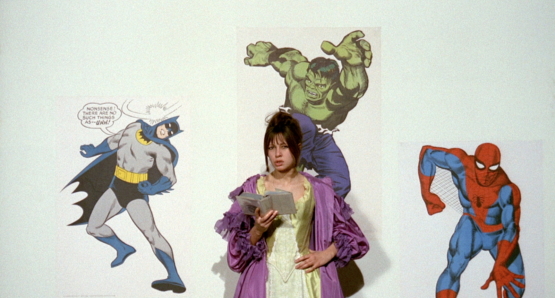
Le Gai savoir (1969) finds Jean-Luc Godard in a period of transition. At the time Godard was becoming progressively more radically Marxist while, as an artist, he was attempting to distill the cinema into its most fundamental form. Le Gai savoir adheres to the cinematographic philosophy inspired by the montages of Dziga Vertov that united Godard with Jean-Pierre Gorin, representing a move away from the artifice of the often conceptually similar La Chinoise (1967). However, the aesthetic modes and operations of Le Gai savoir would be further refined in Godard’s film with Anne-Marie Miéville Comment ça va? (1978).
Le Gai savoir is Godard’s adaptation of the fifth book in Jean-Jacques Rousseau’s Emile, ou De l’éducation. Godard cast Jean-Pierre Léaud as Emile and Juliet Berto as the Sophie character in Emile, ou De l’éducation though he changed her name to Patricia. Godard dispenses with the character details present in Rousseau’s text but retains Rousseau’s socialist approach to gender politics and expands that vein of thinking to encompass those issues most pressing to him: the cinema and the revolution. In terms of form, Le Gai savoir is a kind of Socratic dialogue in which Emile and Patricia interrogate and argue with the complex of sound and image that is the cinema which fills the role of Socrates for Godard.
The bulk of Le Gai savoir takes place on a black and empty sound stage where Berto and Léaud pose in dynamically colored outfits whilst arguing over the meaning of sound, image, etc. Intercut with these scenes are three different types of sequences. One is the Vertov inspired montage of magazine images with words scribbled on them to create juxtaposing meanings and give weight to Godard’s argument that text itself is an image. The second kind of sequence is a shot of a lone figure against a brightly colored backdrop engaging in a word association game with someone else off camera. The third and rarest type of sequence is the handheld footage of Paris city life shot on the quick in the streets.
This complex arrangement of cinematic modes is all to make two essential points about the cinema. The first is that film, which is always a visual record of an event (staged or otherwise), can never be as vital or as impactful as an event occurring in the present reality. To watch a film is therefore the process of seeing as someone else rather than seeing as one’s self. For Godard circa 1969 this means that the cinema as a tool for political instruction and radicalization is not as effective as actively protesting in the streets, the factories, or the universities.
The second point Godard makes in Le Gai savoir is that the cinema, a marriage of sound with image, is merely a technological mode of recording motivated by sentimentality. A record of reality or of fiction serves as a nostalgic object no matter the social or political intent of that record. The synthesis or synchronization of picture and sound creates illusion, intentionally or not, as one surrenders one’s visual and auditory autonomy to the record maker. Under such conditions a political reality cannot be observed nor learned since all that exists is unreality.
The title itself, Le Gai savoir, means “the joy of learning”. That’s what Godard’s great gift was to the cinema; his joy of learning. Even as a transitional film Le Gai savoir is powerful because of Godard’s conviction that continuous self-education was essential cinema making. As of this writing Godard has been deceased for fewer than twenty-four hours. Still, that feels too long for the cinema to be without its greatest advocate and protector. Godard was many things, some good and others bad, but what he gave to the cinema is immeasurable and unequaled.
